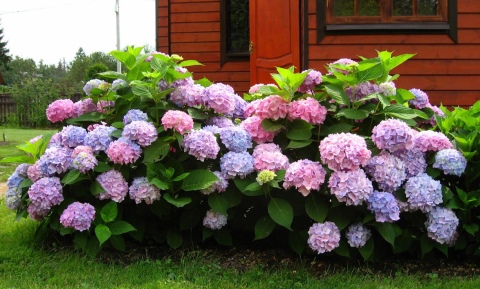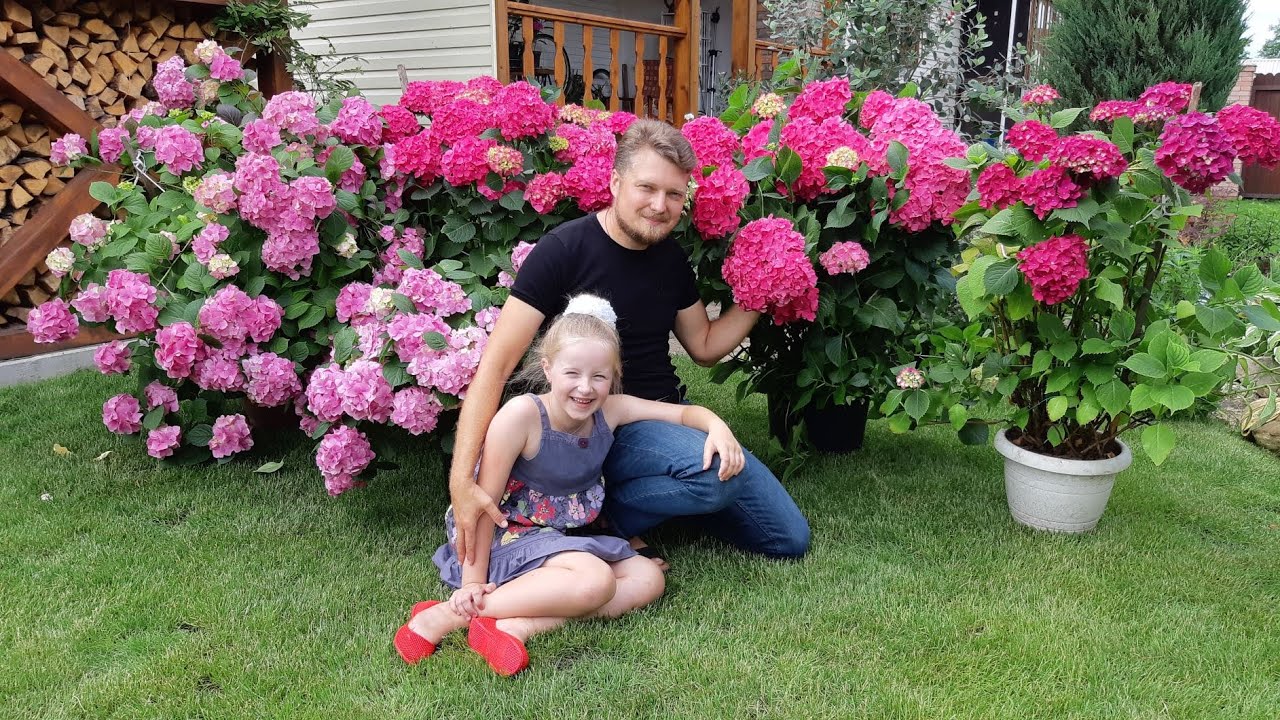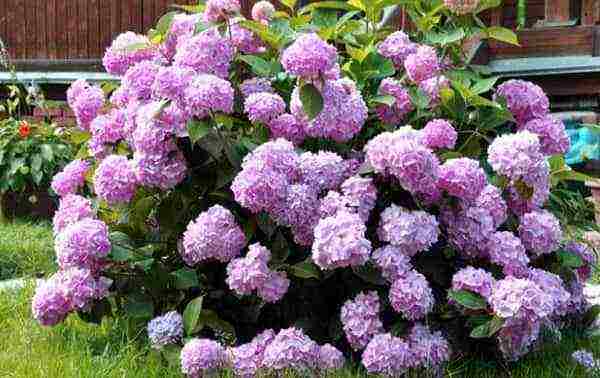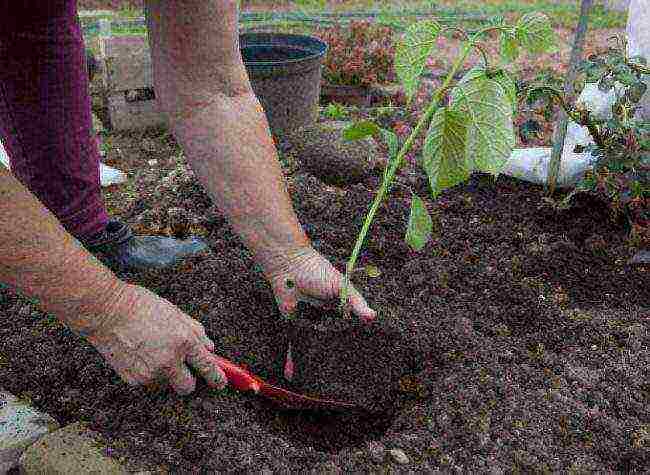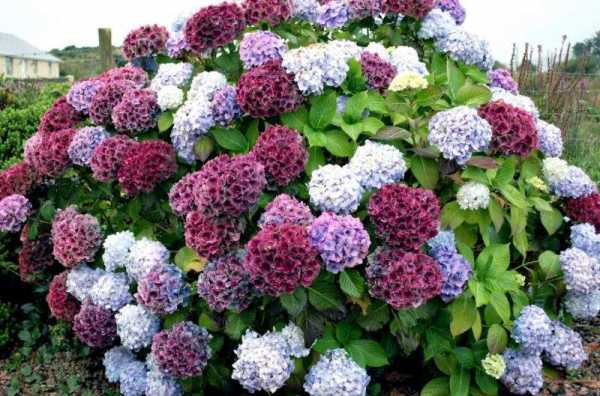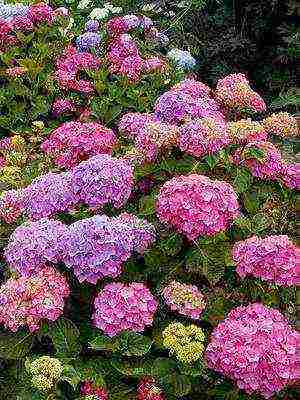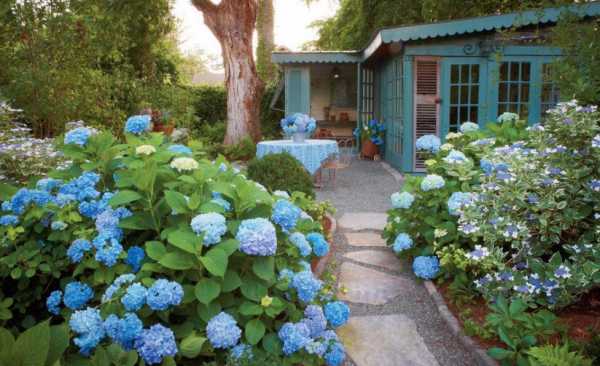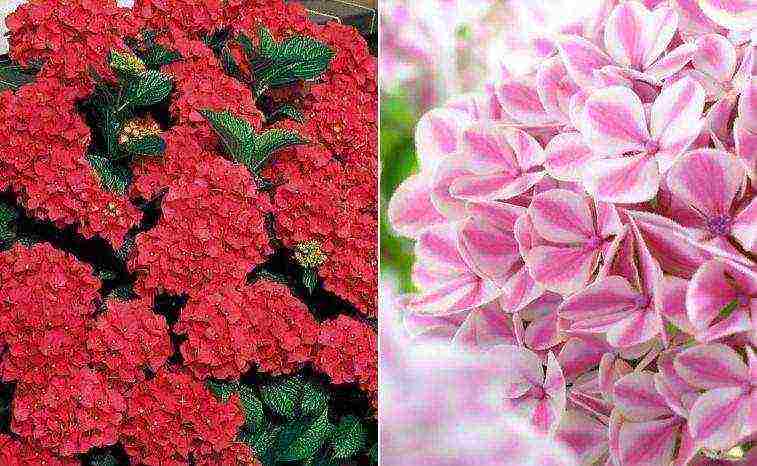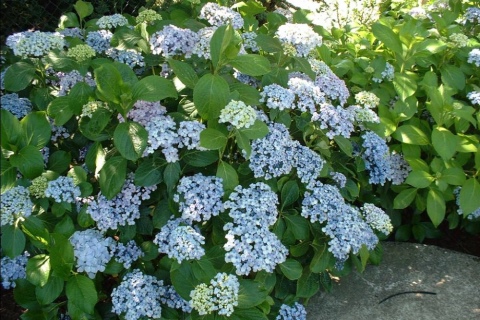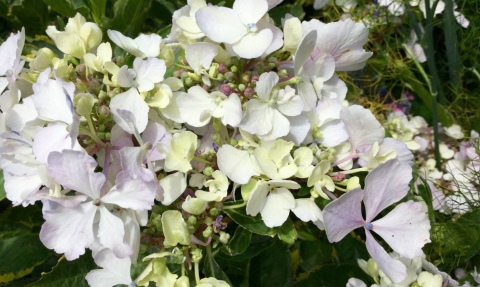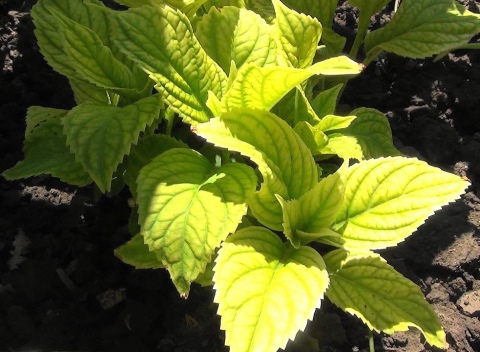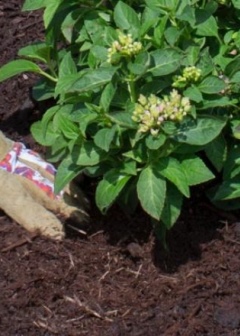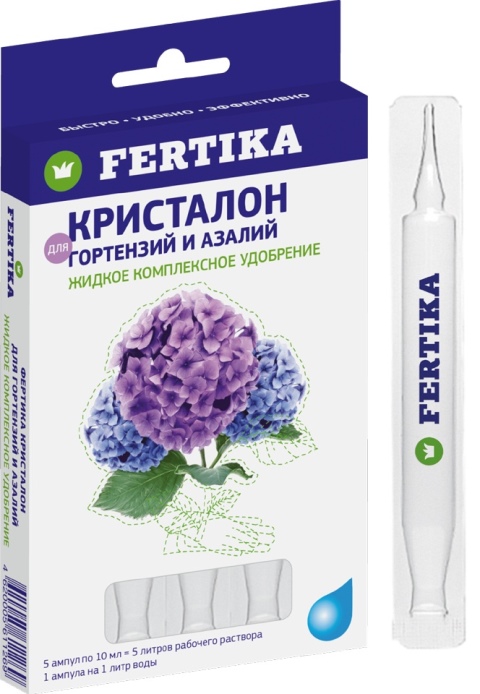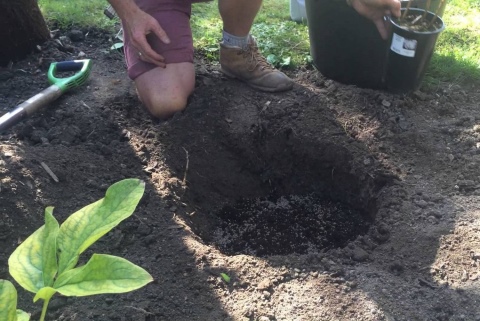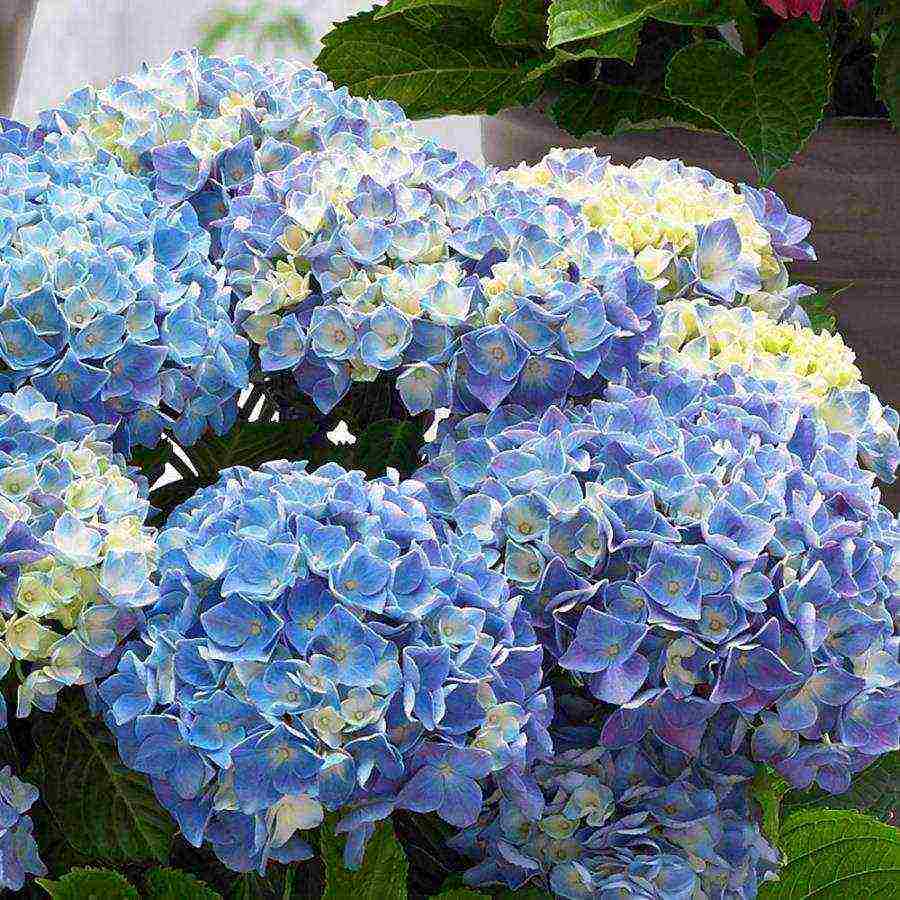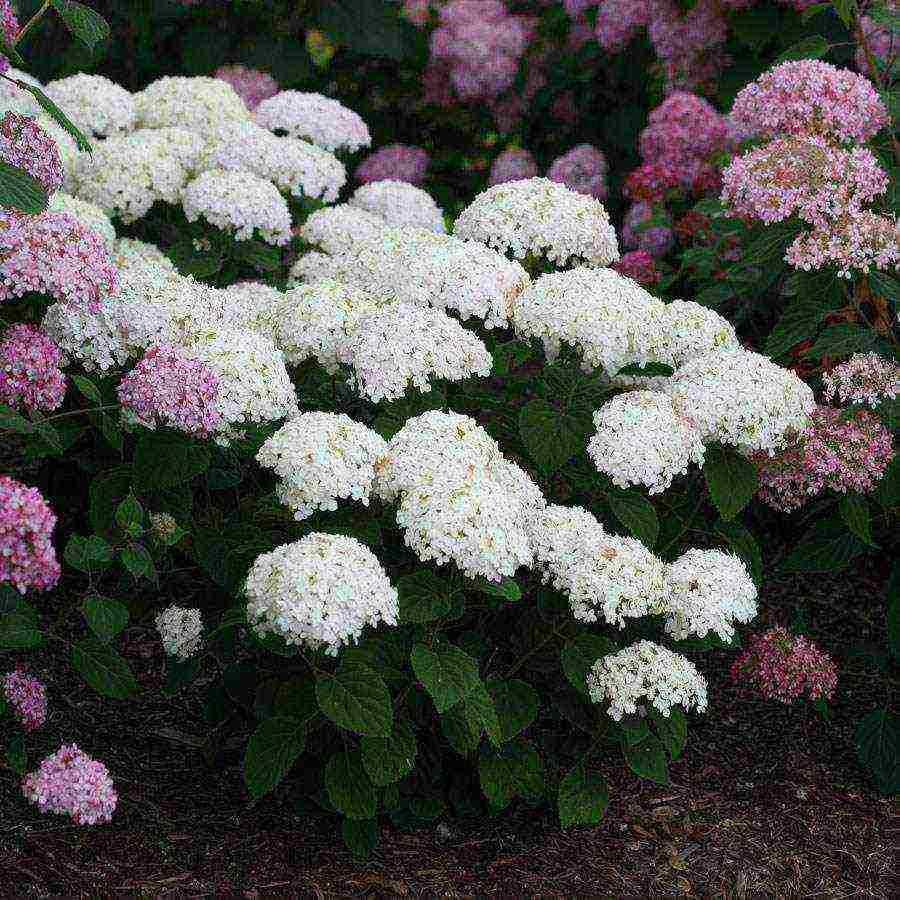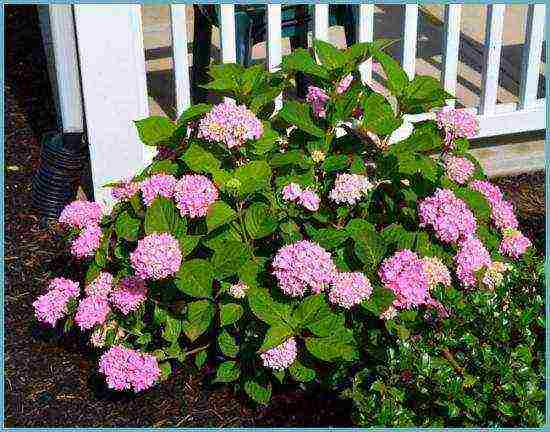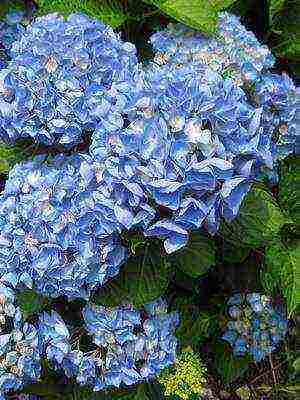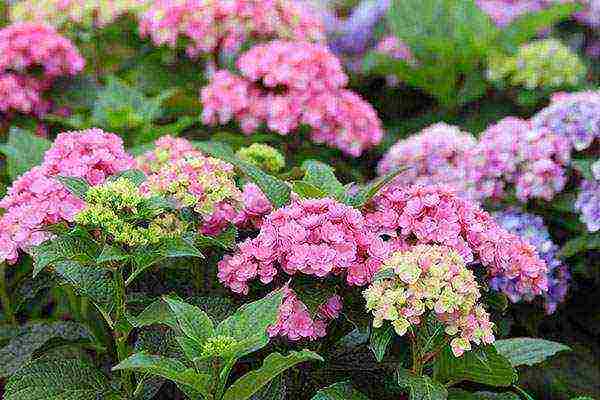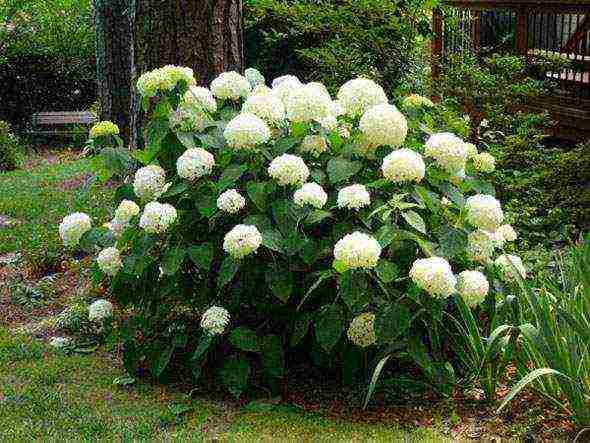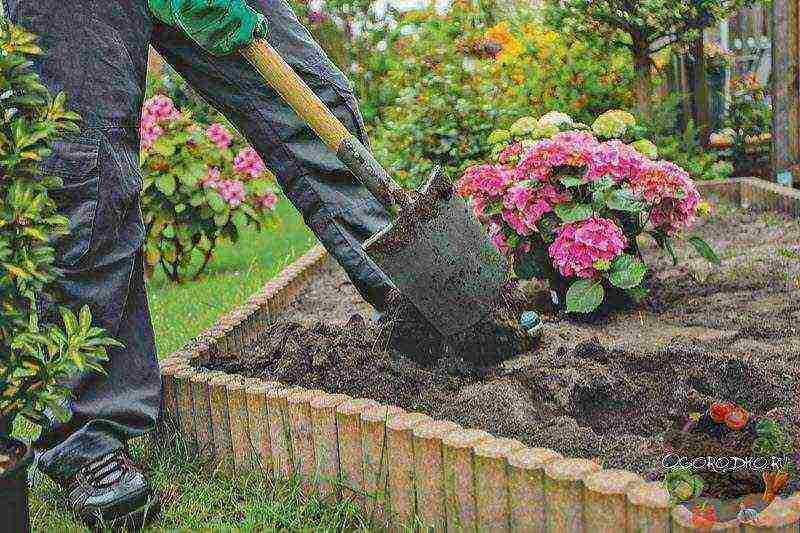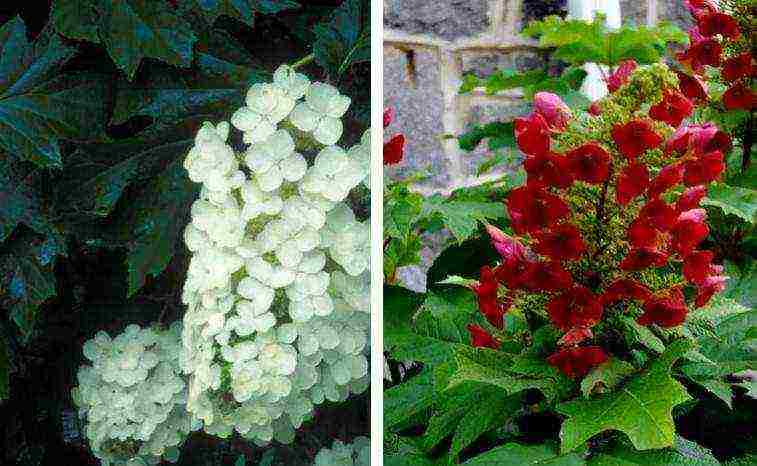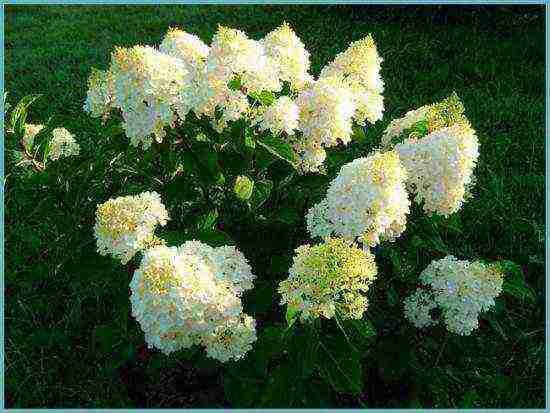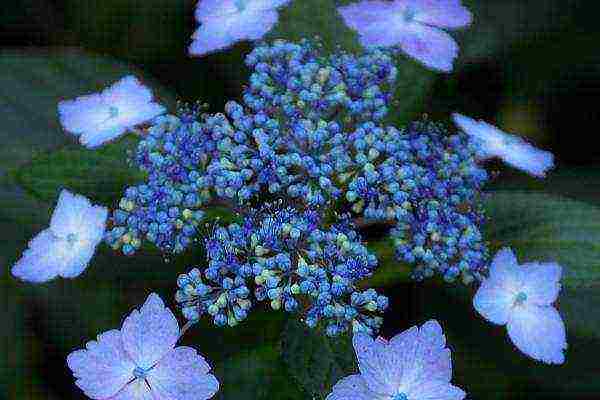Hydrangea Nikko Blue: landing
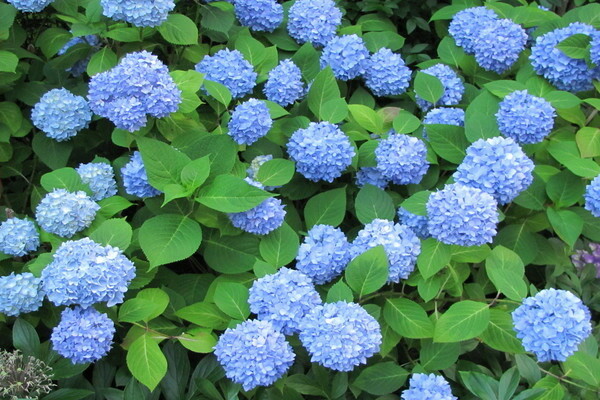
Hydrangea Nikko Blue: photo of the variety
The large-leaved hydrangea Nikko Blue also has a number of requirements for planting. Consider them:
- Preparation. This type of hydrangea should be planted in the spring, although it is possible to do this in the fall, but only until October. The hole is dug out in such a size that the root system of the plant can easily fit in it. But given the fact that this species is growing quite quickly, the hole should be made at least 50 by 50 centimeters, and the same depth. After that, the hole should be filled with such a composition: two parts of peat, two parts of loose garden soil, one part of humus, one part of rotted needles. With a fairly dense and clayey soil, drainage needs to be done, which is laid out on the bottom of the hole. Use small pebbles or expanded clay as drainage. Such actions will help protect the hydrangea root system from decay, and will also help prevent moisture stagnation. Before planting, the root system of the plant must be soaked in water for a while.
- Disembarkation process. Hydrangea Nikko Blue is placed vertically in the center of the prepared hole. The roots are covered with soil. The horse neck of the plant should be deepened, but not completely, quite a bit, there are buds on it that give shoots. The young plant is covered with soil and compacted. After the end of planting the seedling, it needs to be watered well, so that the plant passes the adaptation stage much faster and takes root well. On top of this, after the watering procedure, mulching should be done. Dry peat, needles or sawdust are used as mulch. Such a layer of organic matter will be an excellent option for additional nutrition and will perform protective functions against drying out of the soil.
Description of large-leaved hydrangea
Large-leaved hydrangea is also denoted by other terms: hydrangea, macrophile. The species originates in the east; it was bred in China and Japan.
The largest size of an adult plant ranges from forty centimeters to two meters.
- Hydrangea flowers do not produce seeds, the diameter of the inflorescences is a maximum of 15 centimeters, the average length is 10 centimeters.
- The flowers themselves are quite large. Some specimens are 3.5 centimeters in diameter.
- Stems are upright, covered with large, deep green leaves. The shrub blooms from July to the end of October.
Blooming large-leaved hydrangea conquered the whole world with its lush inflorescences of various shades, and its types such as sargent and petiolate will become a decoration for the garden.
For your information. The peculiarity of this plant is the ripening of flowers on last year's shoots, the buds appear in the fall.
The branches do not stiffen for a long time, therefore they especially suffer from cold weather.
The plant must be carefully prepared for wintering and proper care must be taken during flowering.
This is precisely the complexity of care: insufficient insulation leads to the fact that shoots die and the possibility of the appearance of flowers is lost, and the ingress of moisture leads to infection with a fungus.
You can grow on the site both a hydrangea from a pot and a plant seedling. Caring for different types of plants will be about the same.
Choosing a large-leaved hydrangea variety
Depending on the variety, the conditions of the plant vary.
The gardener can choose from repairing and ordinary macrophile hydrangeas.
When choosing a type of shrub, pay attention to how it tolerates the cold.
- Winter-hardy varieties of hydrangia have been bred, which can cope with 18-degree frosts.
- If you plant a more capricious variety in the middle lane, then the shrub will not please you with flowering after winter.
Advice
Having decided to settle a hydrangea on your site for the first time, turn your attention to proven nurseries and centers that are located in your region.
These shrubs will be more adapted to local conditions than seedlings imported from other countries.
Surely the type of flowers will be more interesting and exotic, but there is a high probability that the plant will not take root.
It is preferable to make your choice in favor of remontant varieties of shrubs.
They differ in that flowers bloom on both old and new shoots.
In case of an unsuccessful wintering, the bush will delight you with several inflorescences that will appear on the branches that have grown this year.
Reproduction paths
Hydrangea is a plant that, thanks to proper and regular care for it, is able to "bestow" unsurpassed beauty. Depending on the variety, it can be pink, white or blue. Therefore, every person who dares to grow a hydrangea will not resist the temptation to propagate this plant in order to then admire the fiery flaming tones of blossoming flowers.

There are many ways of reproduction of large-leaved hydrangea. The most common are:
- division;
- cuttings;
- seeds;
- layering.
It is better to use the simplest methods of hydrangea cultivation, which do not require special knowledge and skills, but which will be within the power of both a professional and a novice gardener.
So, the simplest and most effective way to reproduce broadleaf "charm" is to divide the bush. To do this, you need to dig out a hydrangea bush that has grown over several years and divide it into parts. It is necessary to ensure that buds are present in each part, since it is from them that young growth will grow. Before planting, the roots need to be pruned a little. Each prepared part is then transplanted as a normal plant. If you hold this event in the spring, then by autumn the bushes of the plant will take root.
The next simple, but quite effective method for propagating hydrangea is considered to be propagation by layering. Twigs are removed from the main plant and pressed to the ground. You can secure them with a regular wire clip. This is done in a shallow dug hole about 15 cm in size.It is desirable that the branches that will come into contact with the ground are without leaves. On their underside, you need to make a small incision or just scrape off the bark. Thus, there is little tissue damage, which stimulates the plant to form roots in this place.
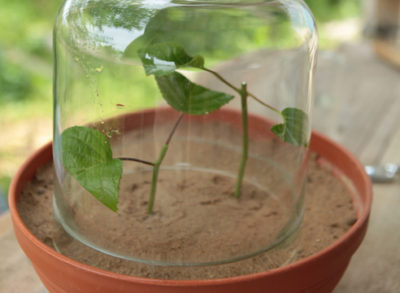
The cuttings should be constantly kept in a humid environment, therefore, so that the roots have already appeared by the fall, the cuttings must be watered as often as possible. You just need to remember that you should not plant the plant right away, you need to wait for spring.
Varieties and varieties
Hydrangea serrata - description of the best varieties, planting and care
Hydrangea serrata is subdivided into varieties. Each variety has its own distinctive features that must be taken into account during cultivation.
Bluebird
Hydrangea Bluebird has characteristics:
- plant height up to 1.5 meters, inflorescences are light blue;
- frost resistance up to -25 ℃;
- oval leaves with a matte finish;
- the inflorescence consists of flat asexual buds and smaller fruiting ones.
The plant prefers partial shade and wet type of soil. Blooms until the end of September.
Description of the Bluebird variety
Koreana
The Koreana variety has an average bush height and has the following characteristics:
- height up to 70 cm;
- variegated buds are most often pink;
- leaves are small, strong shoots with dark bark;
- can withstand frosts down to -15 ℃.
During the flowering period, the buds densely cover the bush, the leaves are practically invisible. Often the panicle is covered with buds of different shades.
Preciosa
Hydrangea Preciosa has distinctive features that set it apart from other varieties. The characteristics of the Preziosa cultivar include:
- the bush grows up to 1.3 meters, but the shoots are not spreading, so the culture looks compact outwardly;
- leaves are bright green in early spring, red in autumn;
- resistance to frost is small, the variety is planted in regions such as the Moscow region;
- the buds change color during the flowering period.
Outdoor Preciosa varieties
Wirl
Hydrangea serratum Veerle grows in shady places. The bush reaches a height of up to 2 meters and has the following features:
- sprawling shoots, a bush can be up to 40 cm wide;
- leaves are large, saturated green;
- blooms with asexual buds of large size, small blue buds are located inside the panicle.
Virle variety
The Virle variety is picky about the type of soil and the amount of nutrients. In the absence of timely fertilizing, the plant grows slowly.
Landing in open ground
Growing Bluebird hydrangea requires compliance with some features that will allow you to get a healthy bush.
Site and soil selection and preparation
It is necessary to plant the plant in mid-late April. During this period, the soil warms up enough and the culture takes root well. Before planting, you need to choose the right site. The plant prefers partial shade, therefore it is recommended to plant a seedling near small fences. It is also necessary to ensure that there are no drafts and closely spaced groundwater.
For the plant to bloom violently, it is necessary to properly prepare the soil. The nutrient mixture for planting should contain the following ingredients:
- peat - 1 part;
- humus - 2 parts;
- sand - 1 part;
- black soil - 2 parts.
The composition is thoroughly mixed and used when planting planting material.
Next to which plants it is better to plant
Hydrangea Bluebird is not picky about neighbors. In the same area with a bush, the following can be grown:
- roses;
- peonies;
- lupine;
- chrysanthemums;
- rhododendron;
- asters;
- fern.
Choosing nearby crops for hydrangea
It is not recommended to plant in the same area with crops that require a lot of sunlight. The sun's rays can harm the delicate leaves of serrata hydrangea, and Bluebird buds also react negatively to prolonged exposure to sunlight.
How to plant
For planting, you need to make a hole 30 cm deep and 40 cm wide. Fill the planting hole with nutrient mixture. A small tubercle is made in the hole and a seedling is placed. The roots of the seedling are carefully straightened, the hole is filled with soil, leaving the root collar on top. Sprinkle with plenty of water.
Bush planting process
Agrotechnics
Conditions for active growth of hydrangea:
- The flower will grow and bloom well in fertile, moist soils;
- The acidity level of the soil should be 5.5 pH;
- If the acidity level is neutral or alkaline, then the soil is acidified by adding aluminum sulfate or peat to it;
- The plant can be planted in partial shade;
- The flower does not tolerate drafts, it cannot be planted on the eastern side of the site;
- The bushes are considered winter-hardy, but when the temperature drops below -28 degrees, a shelter must be made for the hydrangea.
Advantages of serrata hydrangea:
- It does not require special care;
- Rarely exposed to diseases and pests;
- Winter hardiness;
- Long flowering period.
Hydrangea serrated Bluebird
Landing
Hydrangea Bluebird is planted in open ground in the second decade of April. By this time, the earth warms up enough, completely thaws.
A favorable place for planting a flower is partial shade without drafts. Under such conditions, the hydrangea will bloom with voluminous flowers.
Bluebird hydrangea planting and care scheme:
- Prepare a nutritious soil mixture consisting of peat, sand, rotted foliage and fertile humus in a ratio of 1: 1: 2: 2;
- Dig a hole, 30-35 cm deep;
- Put the prepared soil mixture on the bottom of the hole;
- Place seedlings in the center of the hole, the root collar should be flush with the ground;
- Sprinkle the empty space with earth;
- Plants when planting are placed at a distance of 1 m from each other;
- Pour water over the well, add mulch (sawdust, needles), layer thickness - up to 10 cm.
On a note! Hydrangeas grow well on their own, the only condition is to constantly moisten the soil.
Flower care recommendations:
- At temperatures up to 25 degrees, it is necessary to water the bushes in the morning and evening hours. If the days are hot (+30 degrees and above), then the number of waterings is increased. But you can not get on the leaves of the flower, especially in the bright sun;
- Hydrangeas will grow well in partial shade conditions;
- You can get rid of weeds and loosen as needed. Loosening promotes better oxygen penetration into the soil and is a good prophylaxis against parasites and diseases;
- Adult bushes need to be fed during the flowering period. For fertilization, it is recommended to use special balanced mineral preparations intended for hydrangea. Observe the dosage and feeding time, according to the recommendations on the package;
- Bushes need pruning as they grow. The procedure is carried out in the autumn, removing dry and damaged stems. Every 2 years, for preventive purposes, all excess shoots are removed. The procedure improves the condition of the bush, strengthens it.
Hydrangea blooms in July-September under normal development. The flowering period depends on the weather conditions, sometimes flowering can end in August.
There are several reasons why the Bluebird hydrangea does not bloom:
- Lack of moisture;
- The peculiarity of climatic conditions, soil composition;
- The root system does not develop well;
- Insufficient illumination of the site;
- The pruning of the bushes in the spring was done incorrectly;
- The bushes were frozen in winter.
Flowering can be restored on your own, if you take into account the rules for care, recommendations for choosing a site and the composition of the soil.
Interesting. Hydrangea can be planted next to incense, hosts, astilba, barberry, juniper. It is preferable to choose plants that grow in moist soil conditions.
Preparing for winter
In the autumn, prophylactic pruning of hydrangeas is carried out. It is recommended to treat bushes with drugs against pests and diseases. After the foliage has completely fallen off, the bushes are sprayed with 3% Bordeaux liquid.
In September, you can transplant a plant to a new location.
The hydrangea has good frost resistance, but the garden flower needs shelter for the winter. From September, you can begin to cover the bushes. It is necessary to cut off all the bottom leaves to the middle of the bush... After that, mineral fertilizers (superphosphate and potassium salt) are added to the hole.
The branches are carefully tied, forming a bundle, you can bend them a little to the ground. Then they are covered with two layers of special material (spunbond, density g / sq.
m). It is better to cover it without waiting for severe frosts.
4 How do I change the color of a hydrangea?
Large-leaved hydrangea is loved by gardeners and for one more amazing quality - it is a real "chameleon"! That is, you can independently change the color of the inflorescences on your bush from pink to blue or vice versa (the first, by the way, is much easier).
But if you have a white variety of large-leaved hydrangea growing, then it will "refuse" to change color, no matter how you persuade! Only pink and blue hydrangeas lend themselves to "repainting".
Don't believe me? We reveal the secret. To obtain blue colors, the main factors are acidic soil, available aluminum salts (they are responsible for the formation of blue pigment) and a minimum content of phosphorus (it binds aluminum) in the soil. For pink ones, respectively, neutral or alkaline soil and inaccessibility of aluminum salts.
| How to change the color of a hydrangea | |
| To get pink flowers | To get blue flowers |
|
|
Moreover, you can even get multi-colored "balls" on the same bush! To do this, simply fertilize and water its different sides with different substances, or experiment with only one side. Most likely, your bush will turn out to be multi-colored anyway, since in the open field it is very difficult to ensure that absolutely all parts of the plant receive the introduced substances in the same quantities and at the same time - so get ready to observe the whole gamut of shades - from gently -pink to purple or blue.
Don't overdo it with artificially raising the pH of the soil. At values above 6.5, there is a high risk of getting iron deficiency and plant chlorosis.
Hydrangea care rules
Hydrangea care is not difficult. The main thing is to take care of it correctly, observing some requirements.
Watering
Hydrangea is a moisture-loving plant, and therefore it must be watered regularly, but in moderation. In a hot period, it is recommended to water the bush twice a week. One adult plant will require about 30-50 liters of settled warm water. If the plot is mulched, then watering can be reduced, since mulch helps to retain moisture.
Loosening
This procedure is mandatory. It promotes the supply of oxygen to the root system of the plant. During the season, the soil should be loosened several times. The loosening depth is about 5 cm.
Top dressing
If you want the flowering of Hydrangea to be lush, abundant, it must be fed at least twice a season. It is necessary to apply fertilizers before flowering and after its completion. In the spring, the bush should be fed with a urea solution (for 1 liter of water, 2 g of urea will be required). One adult bush will require 30 liters of such a solution. When flowering is over, the bush will need to be fed with complex mineral fertilizers.
Experienced gardeners recommend feeding Hortensia with slurry during the summer. It is necessary to carry out these feeding in moderation, it must be remembered that if the plant is overfeeded, then the inflorescences will be very large, capable of breaking thin stems. In this case, the bush will need to be tied up urgently.
Pruning
Bushes older than 3-4 years are subject to pruning. Hydrangea bushes, the inflorescences of which are formed on the stems of the current year, must be cut in early spring, until the buds open and the process of sap flow begins. However, it should be remembered that cuttings should not be rooted after pruning in early spring.In this regard, pruning should be done at a time when the buds begin to look alive and swell a little.
The longest stems are cut at a height of 3-4 buds. The rest of the shoot can be divided into cuttings. Hydrangeas Paniculata require careful pruning. Last year's stems are shortened by 1/3 part, the rest can also go to cuttings. Large-leaved hydrangea does not need to be heavily pruned. In the spring, only every 4th stem is cut off, especially if it grows inside the bush. In addition, damaged, dried stems are removed.
Post-flowering care
After flowering is complete, it is necessary to remove the wilted inflorescences. If they are left, they will become heavy from rain, snow and can cause damage to fragile shoots.
In late autumn, it is also recommended to huddle the base of the bush trunk high. This operation is a guarantee that the roots of the plant will not freeze in winter.
The most cold-resistant are Paniculata and Groundcover Hydrangea. These species are not afraid of frost, since by autumn their stems are completely lignified.
Shelter of thermophilic species of Hydrangea for the winter
As soon as the first frosts have passed, and this is approximately at the beginning of October, it is necessary to start covering the bush for the winter. It is recommended to cover young specimens to the top with dry soil. The grown bushes are pressed against the surface of the soil, then covered with roofing material or lutrasil. To prevent the shelter from being ripped off by a gust of wind, it must be fixed with bricks.
It will take more time to cover adult bushes. First of all, the bush is neatly tied, covered with spunbond or lutrasil on top. Further, around the bush, a metal frame in the shape of a cylinder is made of mesh. In this case, the walls of the structure should be 20–25 cm away from the bush, and they should also rise 10 cm above it. The voids formed in the structure are filled with dry foliage. In the spring, when stable warm weather is established, the shelter is carefully disassembled.



